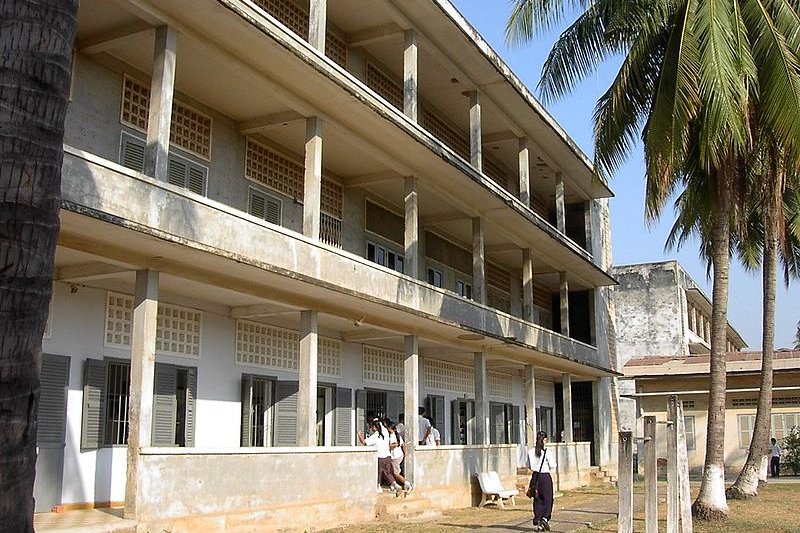 Tuol Sleng Genocide Museum
Tuol Sleng Genocide MuseumSource: https://commons.wikimedia.org/wiki/File:Tuolsleng1.JPG
Author: Adam Carr

Author: Adam Carr

Please be advised that some of the photographs on this page may be disturbing to some viewers.
Tuol Sleng is the name of the school that was turned into a prison during the Khmer Rouge regime. Tuol Sleng wears the badge of notoriety as the Museum of Genocidal Crime. It was here that, during the Khmer Rouge, 20,000 people were interrogated, tortured and subsequently murdered, often with their families as well. Now they stare down at you from their photographs on the wall. Hundreds of those photographs, of people with emptiness in their eyes.
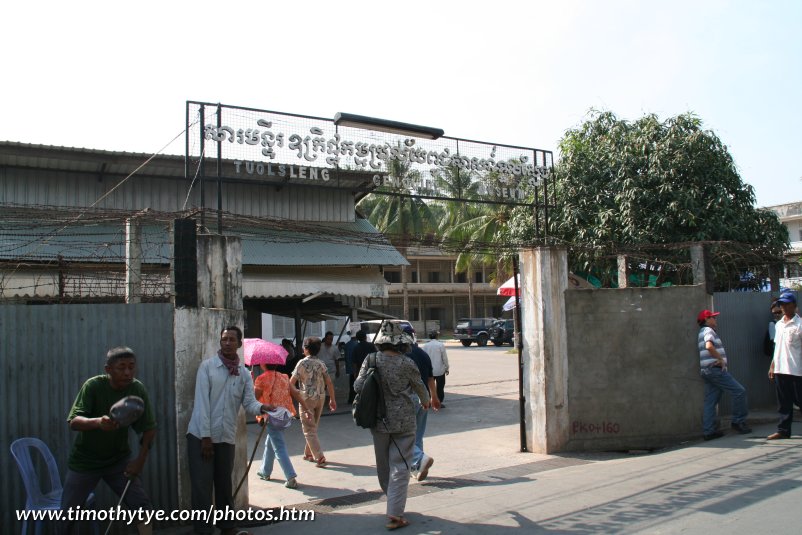 Tuol Sleng Genocide Museum (3 March, 2008)
Tuol Sleng Genocide Museum (3 March, 2008)
The name Tuol Sleng translates as "Hill of the Poison Tree." An apt description indeed. When the Khmer Rouge tooked over Phnom Penh in 1975, they turned the former Tuol Svay Prey High School into the dreaded S-21, the nation's premier incarceration facility.
You walk through the classroom, and you see torture implements. You examine the shackles and cuffs. An empty bed, not for sleep, but murder. Many of the classrooms were partitioned into tiny cells. You can feel the anguish on the walls.
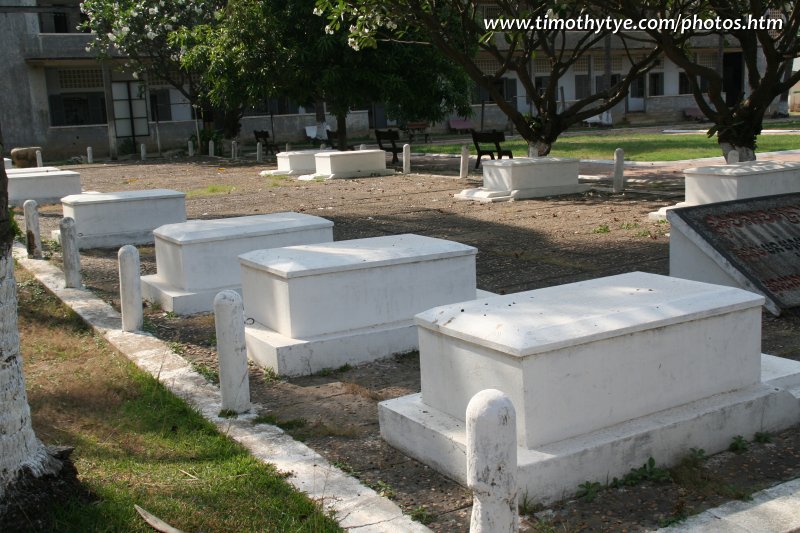 Grave of victims at Tuol Sleng (3 March, 2008)
Grave of victims at Tuol Sleng (3 March, 2008)
The first floor rooms contain evidence of the crimes perpetrated at Tuol Sleng. In a hurry to leave, the Khmer Rouge left behind tens of thousands of pages of incriminating material, together with 7,000 photographic negatives. The S-21 interrogators had their victims signed confessions and kept extensive records of all new arrivals, daily execution schedules as well as torture manuals and records. The prison held between 1,000-1,500 prisoners at any one time. They were repeatedly tortured and forced into naming family members and close associates, who were in turn arrested and similarly tortured and killed.
In the early months of S-21's existence, the victims were mostly from the previous Lon Nol regime and included soldiers, government officials, as well as academics, intellectuals and professionals - doctors, teachers, students, factory workers, monks, engineers, etc. Later, the party leadership's paranoia turned on its own ranks and purges throughout the country saw thousands of party activists and their families brought to Tuol Sleng and liquidated.
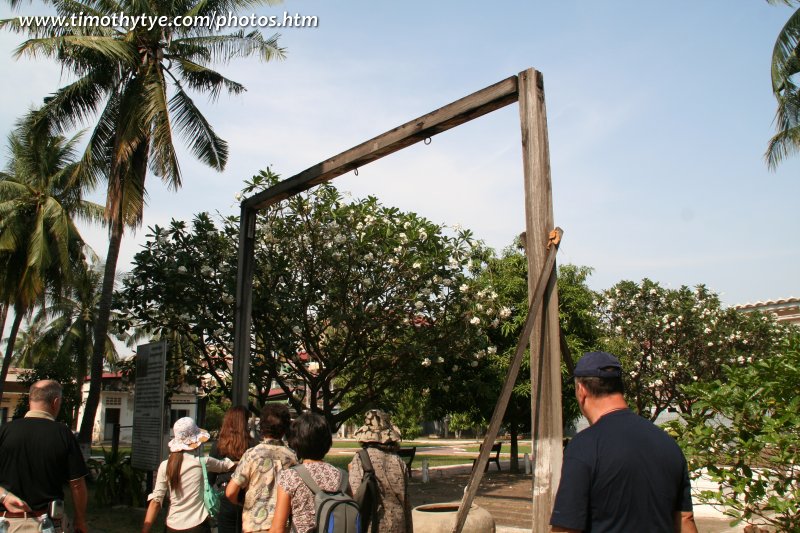 Post for hanging victims at Tuol Sleng (3 March, 2008)
Post for hanging victims at Tuol Sleng (3 March, 2008)
Although many died under torture and were buried in shallow mass graves in the prison grounds, the majority of the 17,000 victims processed through S-21 were trucked at night to Choeung Ek, 15 kilometres outside of the city, forced to dig their own graves before being killed by a blow to the back of the head with a pickaxe or hoe to avoid wasting precious ammunition. I visited Choeung Ek as well, but decided not to show those ghastly photos of human skulls in the pages of AsiaExplorers, out of respect for the victims.
C-block had barbed wire frontage to prevent potential suicides. I saw the ground floor classrooms subdivided into tiny cells by short brick walls about seven foot high. This was where prisoners were held during interrogation. In some cells, manacles and leg irons remain alongside small ammunition boxes that doubled up as latrine cans. The first floor cells are of a wooden construction but equally cramped. Whilst the next level was used for mass detention, both floors are usually off-limits to visitors.
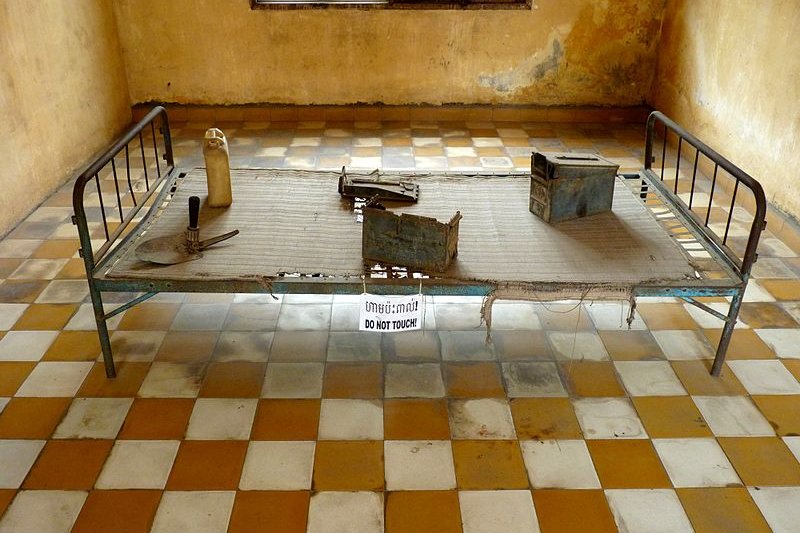 An iron bed at Tuol Sleng
An iron bed at Tuol SlengSource: https://commons.wikimedia.org/wiki/File:Iron_bed_in_Tuol_Sleng_prison.JPG
Author: Dudva

Author: Dudva

D-block holds a collection of paintings, photographs and other items and was used for mass detention under the Khmer Rouge. Graphic colour paintings line the walls. Only seven prisoners are known to have survived S-21 and they were only kept alive because they had skills that proved useful to their captors. Vann Nath was an artist, who'd been held at the centre for exactly one year and had painted oil portraits of Pol Pot. He returned after the liberation to paint a series of scenes, fifteen in all, depicting the harsh realities of life and death at Tuol Sleng and showing examples of the torture methods employed there.
More photographs depict the arrival of the victorious Khmer Rouge in the capital, whilst others show numerous mass grave sites exhumed around the country after their defeat in early 1979. A variety of implements are on display, amongst them wooden water tanks and beds, overlooked by paintings illustrating their actual use as torture techniques. One room contains a few head and shoulder busts of Pol Pot together with their casts, discarded portraits, leg irons, chains and manacles and a series of wall maps.
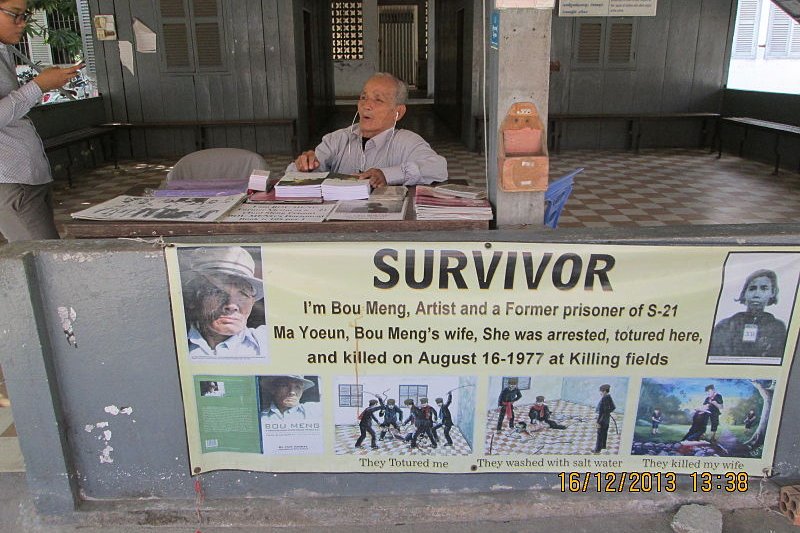 Survivor of Tuol Sleng selling his memoir
Survivor of Tuol Sleng selling his memoirSource: https://commons.wikimedia.org/wiki/File:Survivor_of_Tuol_Sleng_prison_selling_his_memoirs.JPG
Author: Rudolph A. Furtado

Author: Rudolph A. Furtado

In the final room used to hold what was perhaps the most controversial exhibit at Tuol Sleng. On the wall, fifteen feet square in size, was the map of Cambodia created from over 200 skulls of the victims found in shallow graves in Tuol Sleng. The map was finally brought down when the skulls began to decay. Nevertheless a photograph of it remained as a permanent reminder of Khmer Rouge atrocities.
A notice next to the map suggests that 3,314,768 people died as a result of their regime, although recent research suggests a more conservative figure of around 1.7 million. A single storey wooden building, housing the museum offices, guide's quarters and toilets, also has a small gift shop open for business. Whilst Tuol Sleng isn't everyone's ideal memorial, it is nevertheless an important symbol of the crimes perpetrated by Pol Pot and his murderous henchmen that has so affected the psyche of the Cambodian people for the past twenty years.
 Latest updates on Penang Travel Tips
Latest updates on Penang Travel Tips
 Map of Roads in Penang
Map of Roads in Penang
Looking for information on Penang? Use this Map of Roads in Penang to zoom in on information about Penang, brought to you road by road.
Copyright © 2003-2025 Timothy Tye. All Rights Reserved.

 Go Back
Go Back